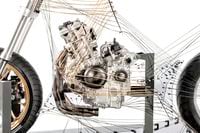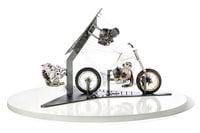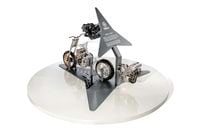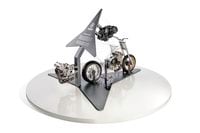Yamaha didn't release any notable new models at the 2012 Intermot Motorcycle Fair, but the company did create lots of buzz—and plenty of questions—with its crossplane triple engine concept. Yamaha shared zero information about the concept beyond some vague mumbo-jumbo about the Japanese philosophy of Jinki Kanno ("…a sense of fullness and satisfaction…") and roundly dodged the most important question: How is a crossplane triple even possible?
In simplest terms, a four-cylinder crossplane engine orients its crankpins 90 degrees apart, so lines drawn through the crankpin and crankshaft centers form an X-shaped cross. A piston then arrives at top-dead-center/bottom-dead-center every 90 degrees of crank rotation, rather than every 180 degrees as on a conventional, single-plane inline-four crank, stabilizing crank speed and eliminating so-called “inertial torque” for smoother power delivery and improved rear-wheel traction. Or so says Yamaha.
Almost every inline triple made—including those from Triumph and MV Agusta—uses crankpins oriented 120 degrees apart to form a Y cross section, not an X. This reduces inertial torque but doesn’t eliminate it. Some suggested Yamaha just lopped one cylinder off the end of an R1 crank, leaving the center cylinder offset 90 degrees from two outer cylinders that would be 180 degrees apart-but that wouldn’t completely zero out inertial torque, either.
A better guess is that the crossplane triple incorporates a fourth “slave” piston (or other reciprocal balancer) to counteract the center piston’s movement. Yamaha currently uses a similar solution to balance its TMAX scooter parallel-twin engine. The prototype engine (shown here in a whimsical wire-framed styling exercise) is surprisingly compact except for what appears to be an unusually deep oil sump—perfect for accommodating a slave piston or other balance weight.





/cloudfront-us-east-1.images.arcpublishing.com/octane/7OWQWAWJBFCGTAYQWBMWGNMNB4.jpg)
/cloudfront-us-east-1.images.arcpublishing.com/octane/4G5XKCDIHRCGRHVF7OPORG7ZX4.jpg)
/cloudfront-us-east-1.images.arcpublishing.com/octane/D2BDYKKNZ5GRHGDMI4PZTGRMME.jpg)

/cloudfront-us-east-1.images.arcpublishing.com/octane/UAY4WSZPOFDQRP4MCEXAKDFQOQ.jpg)

/cloudfront-us-east-1.images.arcpublishing.com/octane/X5CE3KSJHZHM5CUFGPZ7U26WB4.jpg)
/cloudfront-us-east-1.images.arcpublishing.com/octane/COWLTPGFAFGDDGJCTENYMA4VJM.jpg)
/cloudfront-us-east-1.images.arcpublishing.com/octane/H3PKUGPSUJFTND4RFPSI4OIDCE.jpg)
/cloudfront-us-east-1.images.arcpublishing.com/octane/UHGQA3MQDFCA3HLBWF7S76WH6Y.jpg)
/cloudfront-us-east-1.images.arcpublishing.com/octane/Q5EORCSTNFAVBJC4IYUHIKJTXQ.jpg)
/cloudfront-us-east-1.images.arcpublishing.com/octane/XIJ5FUFSP5A3NL7MOVZGJXAHC4.jpg)
/cloudfront-us-east-1.images.arcpublishing.com/octane/V5NZN3CGS5B5PPYFYJHIPAU5S4.jpg)
/cloudfront-us-east-1.images.arcpublishing.com/octane/CZE6ONOBU5E7HPIEEADU376C4M.jpg)
/cloudfront-us-east-1.images.arcpublishing.com/octane/UT4KL3SIYJBSPNHWJXTBE6MTGE.jpg)
/cloudfront-us-east-1.images.arcpublishing.com/octane/Q3UOIDZ22ZEVDBZUWGJXIMGJKI.jpg)
/cloudfront-us-east-1.images.arcpublishing.com/octane/YQM66WXZV5AAXNNOIUVOGVXZMY.jpg)
/cloudfront-us-east-1.images.arcpublishing.com/octane/J47NFTXNLFFGHELHZCUD2LCITA.jpg)
/cloudfront-us-east-1.images.arcpublishing.com/octane/NXPQBTLX3NCILKQ2GCFJYNIDEM.jpg)
/cloudfront-us-east-1.images.arcpublishing.com/octane/6U7NJLAYMRBZTIGNKWIA5OK2FQ.jpg)
/cloudfront-us-east-1.images.arcpublishing.com/octane/IYTZQWUROVC25IMTDEWUDQ5IQE.jpg)
/cloudfront-us-east-1.images.arcpublishing.com/octane/YJODDXEL2ZB5TENKPPN4BEYJAE.jpg)
/cloudfront-us-east-1.images.arcpublishing.com/octane/QEQQUZYNJFAIJB4DZFVFSNTCQ4.jpg)
/cloudfront-us-east-1.images.arcpublishing.com/octane/F4EEHDT3UZFKPLKVGDWMMPFEQE.jpg)